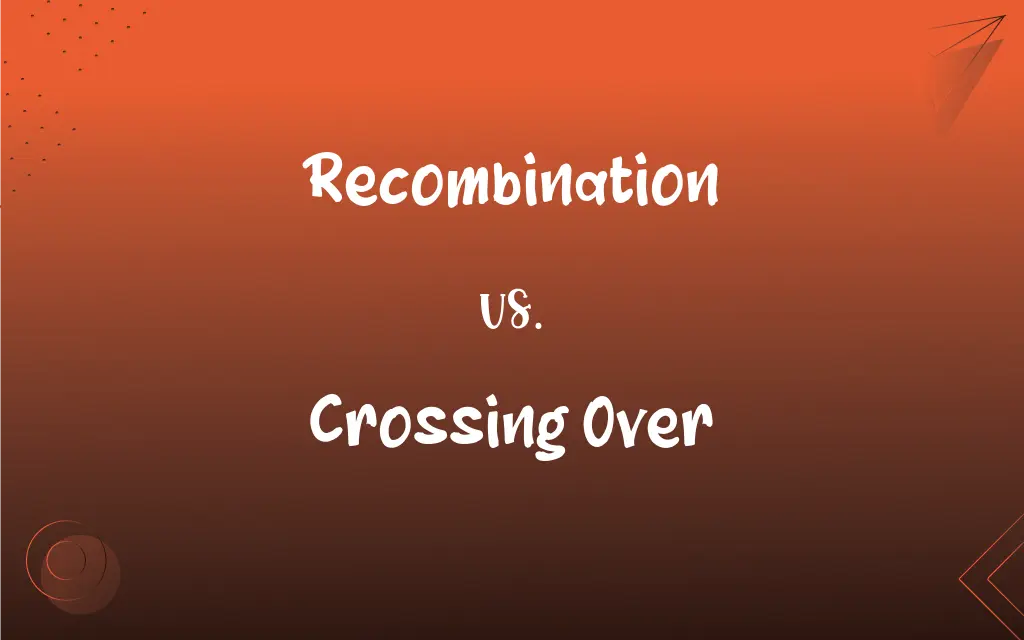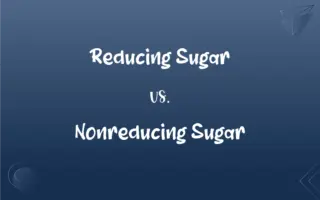Recombination vs. Crossing Over: What's the Difference?
Edited by Aimie Carlson || By Harlon Moss || Updated on October 29, 2023
Recombination is the rearrangement of genetic material, while crossing over is a specific type of recombination occurring between homologous chromosomes during meiosis.

Key Differences
Recombination refers to a broader process wherein genetic material gets rearranged, while crossing over is a mechanism by which this rearrangement can occur. Both recombination and crossing over contribute to genetic diversity, but they are not synonymous.
At its core, recombination encompasses a variety of processes that lead to new combinations of genes. On the other hand, crossing over is a physical exchange of chromosome segments between paired homologous chromosomes, specifically during meiosis.
While recombination can happen in various ways, such as through gene conversion or independent assortment, crossing over stands out as a unique, tangible event where pieces of chromatids physically break and rejoin on the paired chromosome.
In the realm of genetics, recombination is hailed for creating novel gene combinations, thus driving evolutionary adaptations. Meanwhile, crossing over serves as one of the primary sources of this genetic variation, making it a critical component of the recombination process.
To summarize, while recombination is a broad genetic phenomenon resulting in novel gene combinations, crossing over is a distinct event during meiosis that facilitates this genetic reshuffling.
ADVERTISEMENT
Comparison Chart
Definition
General process of genetic material rearrangement.
Specific type of recombination between homologous chromosomes.
Occurs during
Can happen during various cellular processes.
Specifically during meiosis.
Result
New combinations of genes.
Exchange of genetic material between non-sister chromatids.
Mechanism
Can involve several methods (gene conversion, independent assortment, etc.)
Physical exchange of chromosome segments.
Contribution to Diversity
Creates genetic variation in populations.
One of the main sources of genetic variation during recombination.
ADVERTISEMENT
Recombination and Crossing Over Definitions
Recombination
The process by which genetic material is rearranged.
Through recombination, organisms achieve increased genetic diversity.
Crossing Over
The physical exchange of chromosome parts between non-sister chromatids.
Chiasmata are the visible manifestations of crossing over.
Recombination
A mechanism for introducing genetic variation.
The evolutionary significance of recombination cannot be understated.
Crossing Over
A mechanism that contributes to the genetic uniqueness of offspring.
Thanks to crossing over, siblings can have quite varied genetic profiles.
Recombination
A phenomenon that leads to new gene combinations.
Recombination is responsible for some of the genetic variations seen in populations.
Crossing Over
An event during meiosis where homologous chromosomes exchange segments.
Crossing over results in chromatids with new combinations of genes.
Recombination
Genetic reshuffling that can happen during various cellular activities.
Recombination ensures that offspring have a mix of parental traits.
Crossing Over
A specific form of recombination between paired chromosomes.
During meiosis, crossing over introduces genetic variation in gametes.
Recombination
The process that can incorporate genes from one organism into another's genome.
Bacterial recombination allows for the rapid spread of antibiotic resistance.
Crossing Over
The breakage and rejoining of paired homologous chromosomes.
The frequency of crossing over can provide insights into the genetic distance between genes.
Recombination
The natural or artificial rearrangement of genetic material in living organisms or viruses, especially the creation in offspring of sexually reproducing parents of new combinations of genes through the process of crossing over during meiosis.
FAQs
What is recombination in genetics?
Recombination is the process by which genetic material is rearranged, leading to new gene combinations.
Why is recombination significant in evolution?
Recombination introduces genetic variation, which can drive evolutionary adaptations.
Can recombination occur without crossing over?
Yes, recombination can happen through various mechanisms, of which crossing over is just one.
Is crossing over limited to meiosis?
Yes, crossing over specifically occurs during meiosis between homologous chromosomes.
How does recombination differ from mutation?
While both introduce genetic variation, recombination reshuffles existing genes, while mutations introduce new genetic changes.
What visible evidence supports crossing over?
Chiasmata, or visible points of crossover, are evidence of crossing over.
Does crossing over affect every chromosome during meiosis?
While crossing over is common, not every chromosome may undergo it during every meiotic event.
Is crossing over equally likely between all genes?
No, crossing over frequencies can differ based on genetic distance and chromosomal location.
Are all products of crossing over viable?
Most are viable, but improper crossing over can lead to genetic abnormalities.
Why is crossing over crucial for sexual reproduction?
Crossing over ensures genetic diversity in offspring, which is a hallmark of sexual reproduction.
Can recombination introduce new genes?
While recombination reshuffles existing genes, horizontal gene transfer can introduce new genes, especially in bacteria.
How does crossing over relate to recombination?
Crossing over is a specific type of recombination that occurs between homologous chromosomes during meiosis.
Can recombination happen in bacteria?
Yes, bacteria can undergo recombination, incorporating genes from one organism into another's genome.
What's the relationship between chiasmata and crossing over?
Chiasmata are visible manifestations of the points where crossing over has occurred.
Are recombination and crossing over random processes?
While they introduce variation, there are regulatory mechanisms governing when and where they occur.
What genetic structures are directly involved in crossing over?
Non-sister chromatids of homologous chromosomes are directly involved in crossing over.
How does the rate of recombination vary?
Recombination rates can vary by species, individual, and genomic location.
How does recombination impact populations?
Recombination contributes to genetic diversity within populations, affecting evolution and adaptation.
How does recombination influence genetic mapping?
Recombination frequencies can be used to determine genetic distances between genes, aiding in mapping.
How does recombination contribute to genetic diversity?
Recombination leads to offspring with combinations of genes different from either parent, increasing diversity.
About Author
Written by
Harlon MossHarlon is a seasoned quality moderator and accomplished content writer for Difference Wiki. An alumnus of the prestigious University of California, he earned his degree in Computer Science. Leveraging his academic background, Harlon brings a meticulous and informed perspective to his work, ensuring content accuracy and excellence.
Edited by
Aimie CarlsonAimie Carlson, holding a master's degree in English literature, is a fervent English language enthusiast. She lends her writing talents to Difference Wiki, a prominent website that specializes in comparisons, offering readers insightful analyses that both captivate and inform.































































